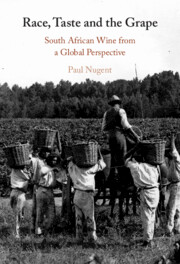191 results
19 - Beyond the Notes
- from Part IV - Building a Career
-
-
- Book:
- The Cambridge Companion to Composition
- Published online:
- 25 May 2024
- Print publication:
- 30 May 2024, pp 301-312
-
- Chapter
- Export citation

Space, Place, and Bestsellers
- Moving Books
-
- Published online:
- 17 May 2024
- Print publication:
- 13 June 2024
-
- Element
- Export citation
8 - The Supply and Demand of Law
- from Part IV - The Evolution of Lawfare
-
- Book:
- The Violence of Law
- Published online:
- 30 April 2024
- Print publication:
- 02 May 2024, pp 359-470
-
- Chapter
- Export citation
9 - The Marketing of Genocide
- from Part IV - The Evolution of Lawfare
-
- Book:
- The Violence of Law
- Published online:
- 30 April 2024
- Print publication:
- 02 May 2024, pp 471-508
-
- Chapter
- Export citation
8 - Land Reform and Rural Production in South Africa
- from Part II - Potentials and Pitfalls of South African Land Reform
-
-
- Book:
- Beyond Expropriation Without Compensation
- Published online:
- 28 March 2024
- Print publication:
- 04 April 2024, pp 190-213
-
- Chapter
-
- You have access
- Open access
- HTML
- Export citation
3 - Orchestrating a White Wine Revolution
-
- Book:
- Race, Taste and the Grape
- Published online:
- 16 March 2024
- Print publication:
- 28 March 2024, pp 105-127
-
- Chapter
- Export citation
5 - Bureaucracy without the State
-
- Book:
- Race, Taste and the Grape
- Published online:
- 16 March 2024
- Print publication:
- 28 March 2024, pp 148-180
-
- Chapter
- Export citation
6 - Selling Wine to the Many
-
- Book:
- Race, Taste and the Grape
- Published online:
- 16 March 2024
- Print publication:
- 28 March 2024, pp 181-223
-
- Chapter
- Export citation
Western Safflower Contracting Strategies
-
- Journal:
- Journal of Agricultural and Applied Economics / Volume 56 / Issue 2 / May 2024
- Published online by Cambridge University Press:
- 19 March 2024, pp. 216-233
-
- Article
-
- You have access
- Open access
- HTML
- Export citation

Race, Taste and the Grape
- South African Wine from a Global Perspective
-
- Published online:
- 16 March 2024
- Print publication:
- 28 March 2024
Chapter 7 - Publishing in the 1860s
-
-
- Book:
- Nineteenth-Century Literature in Transition: The 1860s
- Published online:
- 01 February 2024
- Print publication:
- 08 February 2024, pp 129-146
-
- Chapter
- Export citation
6 - Industry, Agency, and Opera Arrangements in Czerny’s Vienna
-
- Book:
- Opera in the Viennese Home from Mozart to Rossini
- Published online:
- 18 February 2024
- Print publication:
- 18 January 2024, pp 182-230
-
- Chapter
- Export citation
Chapter 6 - Literature in the Electric Age
- from Part I - Origins
-
-
- Book:
- Technology and Literature
- Published online:
- 30 November 2023
- Print publication:
- 14 December 2023, pp 125-140
-
- Chapter
- Export citation
Testing a conceptual Hierarchy of Effects model of food marketing exposure and associations with children and adolescents’ diet-related outcomes
- Part of
-
- Journal:
- Public Health Nutrition / Volume 27 / Issue 1 / 2024
- Published online by Cambridge University Press:
- 07 December 2023, e10
-
- Article
-
- You have access
- Open access
- HTML
- Export citation
The relationship between parent's self-reported exposure to food marketing and child and parental purchasing and consumption outcomes in five countries: findings from the International Food Policy Study
-
- Journal:
- Journal of Nutritional Science / Volume 12 / 2023
- Published online by Cambridge University Press:
- 07 December 2023, e123
-
- Article
-
- You have access
- Open access
- HTML
- Export citation
Lazy, Selfish and Ruthless: Marketing Legal Information Services
-
- Journal:
- Legal Information Management / Volume 23 / Issue 4 / December 2023
- Published online by Cambridge University Press:
- 02 February 2024, pp. 230-235
- Print publication:
- December 2023
-
- Article
- Export citation
Increasing Your Visibility and Going Beyond Your Job Title: the Pros and Cons of Saying Yes to Everything
-
- Journal:
- Legal Information Management / Volume 23 / Issue 4 / December 2023
- Published online by Cambridge University Press:
- 02 February 2024, pp. 236-239
- Print publication:
- December 2023
-
- Article
- Export citation
Chocolate unicorns and smiling teddy biscuits: analysis of the use of child-directed marketing on the packages of Australian foods
-
- Journal:
- Public Health Nutrition / Volume 26 / Issue 12 / December 2023
- Published online by Cambridge University Press:
- 14 November 2023, pp. 3291-3302
-
- Article
-
- You have access
- Open access
- HTML
- Export citation
Chapter 4 - How Social Media Can Influence Group and Individual Behaviour: Practice Implications
- from Section 1 - Understanding Social Media
-
-
- Book:
- Social Media and Mental Health
- Published online:
- 11 October 2023
- Print publication:
- 12 October 2023, pp 33-44
-
- Chapter
- Export citation
Chapter 10 - Social Media and Gambling
- from Section 2 - Social Media and Mental Health
-
-
- Book:
- Social Media and Mental Health
- Published online:
- 11 October 2023
- Print publication:
- 12 October 2023, pp 98-108
-
- Chapter
- Export citation



